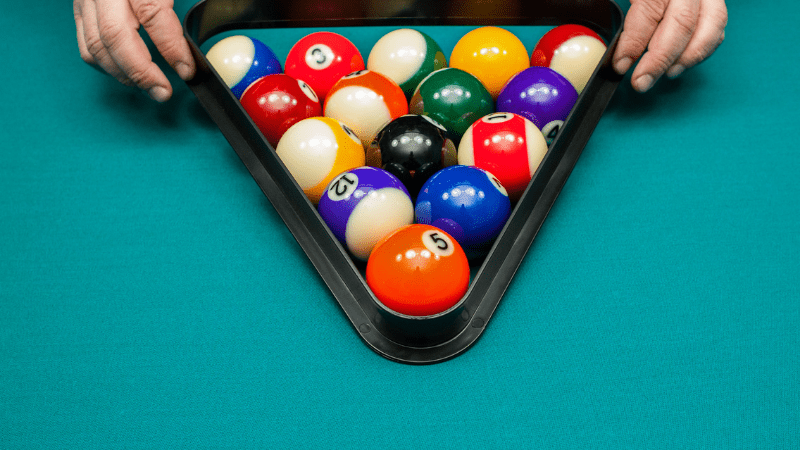There’s no sound quite like someone breaking in a game of pool, hitting the cue ball into the group and sending the balls rolling across the table. It’s even better when you hear one of those balls (not the cue ball, of course) drop into one of the pockets. Pool balls are small, but if you’ve ever dropped one on your foot, you know they’re also uniquely heavy. All of these characteristics of pool balls have many wonders, what are they made of?
Once upon a time, pool balls were made from stone, but in the modern-day, stone is a bit difficult to work with, and a material known as phenolic resin is used instead. This makes a more seamless and successful play session for the user.
Whether you agree or not with the movement away from playing with stone pool tables balls, keep reading to learn more about them and compare the different types available on the market.
What Do They Make Pool Table Balls Out Of?
In the 1340s, royalty and high society members played games in their yards that seemed to be a mix of billiards and croquet. This game eventually evolved into table billiards which is still played today. The balls were originally made of wood and clay but proved to create too much variation from game to game due to damages to the ball and the table.
Creators of pool table balls then discovered ivory and wanted the “best” for their high-paying clients. The ivory billiards balls were a display of status, and there are still some sets out there that are on display. However, they discovered that ivory was not a practical product to use after a while as one tusk would yield only four or five balls and, at most, eight balls. Ivory was also prone to yellowing and cracking under high humidity or if struck with excessive force.
Makers of pool balls then discovered a resin and plastic combination called phenolic resin that was cheaper and more efficient. It also created a better product that did not vary as much from ball to ball. This company was called Saluc and is located in Belgium.
You have probably never heard of Saluc, but you are likely to recognize the brand of billiard balls that they produce. Saluc is the manufacturer of Brunswick and Aramith billiard balls. They are the largest manufacturer of billiard balls in the world, and they started as a hide tanning company.
What is Phenolic Resin?
In the modern-day, almost all pool balls are made from phenolic resin. This combination of resin and plastic resisted damage more than previous designs, and it caused less damage to tables, therefore creating less variation in a players’ game.
Phenolic resin will last five times longer than previous designs due to its high gloss polish. This high gloss polish creates less friction between the table and the balls, resulting in longer-lasting products.
The phenolic resin goes through a heat curing process which stabilizes the material through each ball, creating a true center. This means that the ball’s weight is evenly distributed and will be more balanced, and have a more accurate roll. The heat curing process also makes the phenolic resin balls harder and withstand more impacts from the cue.
The phenolic resin billiard balls go through a 13-step manufacturing process and have to pass seven different criteria. The criteria that the craftsman looks for are density, balance, roundness, diameter tolerance, color precision, surface polish, and brilliance. This process takes 23 days. As you can see, the process to create billiard balls is a long and meticulous one.
What is the Best Type of Pool Table Balls to Use?
In the modern-day, you can find pool table balls made of two materials, the phenolic resin mentioned above or polyester resin. While both have their benefits, phenolic resin balls, while more expensive, tend to last longer than their polyester counterparts.
Polyester resin balls tend to be cheaper than the phenolic resin versions, but they cannot withstand the hard play that a nice phenolic resin ball can. Therefore the phenolic resin balls are typically the ones that are preferred by most professional players.
And if you plan to play pool frequently, it is highly recommended that you pick up a phenolic resin set, as these tend to keep their shine and nice look longer—meaning you can show off your billiards set for years to come.
Final Thoughts
To sum it all up, billiard balls have changed significantly since the beginning of the game in the 1340s. And in the modern-day, all balls you purchase are made of either phenolic resin or polyester resin.
For balls that will last as long as your pool table, stick to purchasing phenolic resin pool table balls. But if you’re on a budget, then some polyester resin balls may help you fill the gap until you can purchase a nicer set.

